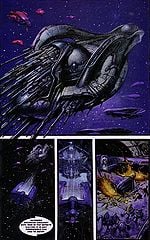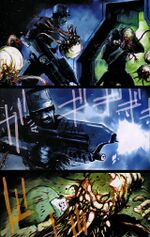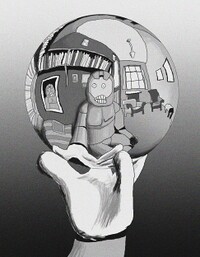Halo Graphic Novel
From Halopedia, the Halo wiki
The Halo Graphic Novel is a graphic novel published by Marvel Comics in partnership with Bungie Studios. The Halo series began with the award-winning popular video game Halo: Combat Evolved, which spawned several books as well as video game sequels, and is focused on the story of future humanity fighting against a powerful collective of races called the Covenant. The Halo Graphic Novel is the series' first entry into the sequential art medium, and features aspects of the Halo universe which until then had not been discussed or seen in any medium.
The majority of the book is divided into four short stories by writers and artists from the computer game and comic industries. Each tale focuses on different aspects of the Halo universe, revealing stories that are tangential to the main plot of the game. The book also contains an extensive art gallery compiled of contributions from Bungie, Marvel and independent sources. Released on July 19, 2006,[1] the Halo Graphic Novel was well-received, with reviewers noting the cohesiveness of the work as a whole, as well as the diversity of the individual material. The success of the novel led to Marvel announcing a new limited comic series,[2] which became known as Halo: Uprising.
Background and publication
Bungie Studios' original concept of the graphic novel was to bring the Halo series into new media beyond that of video games, with sequential art being the main focus.[3] Initially unsuccessful in its pursuit of finding a partner and an effective license agreement, Lorraine McLees—an artist on the Halo development team—suggested that Bungie Studios finance and edit the novel itself before pursuing a publisher. This would allow the studio to maintain control over the content and pursue the venture unencumbered by outside intervention.[3] This also gave the studio greater access to various artists that it hoped would contribute; the novel’s executive producer Brian Jarrad noted the procedure of creating the novel independently and outside the "traditional comic process" would prevent the "conflicts of interest and politics and allegiances" that could potentially arise if they approached a publisher or partner first.[4] Lead designer Maria Cabardo created a "dream team" roster of writers and artists Bungie admired, and through a period of negotiation Bungie was able to gain contributions from many of those named on the list.[4] Buoyed by their success in approaching those in the medium that they respected and admired, including British comic book artist Simon Bisley and French artist Jean "Moebius" Giraud, the progress of Halo Graphic Novel was described as a "cool morale boost for our team to see their universe, their characters, realized by people that we idolize in the comic industry."[5]
The novel was completed after a two-year development cycle and Bungie sought out a publisher, eventually approaching Marvel Comics. Bungie cited Marvel's "passion for Halo" and "reach in the comic and publishing industry" as the main draws to the company.[3] The studio worked alongside Marvel director of development Ruwan Jayatilleke, an early champion of the project, to assist in the distribution and publication of the novel.[6][7]
The stories themselves were designed as glimpses into the Halo universe, including information on the inner workings of the alien Covenant, as well as details regarding elements of the back-story that were hitherto undisclosed. Jarrad explained that "The stories that happen off camera, the parallel events to the arcs that our fans know from the existing mediums, are the stories we really wanted to tell."[6] Jarrad further described this as an attempt to move away from the story of the Master Chief, the central character of the franchise, and focus instead on what they believed to be the core themes that lay behind the game universe, such as maintaining hope in the face of overwhelming odds and humanity's struggle for survival; themes that extended beyond "… a genetically enhanced super soldier picking up two guns and kicking some alien butt."[6] The four stories that ended up in the final publication were "the most interesting to Bungie and the writers of [the novel]".[8] Although Bungie created the story arcs present in the Halo Graphic Novel, the studio described the importance of providing a framework for each story that the various artists and writers could tell without jeopardizing their own voice.[6] Artist Simon Bisley said that "the stress was to make the characters look very much as they do in the game. Beyond that point I was given free rein to interpret the script and the action" based on what was given to the artists and writers.[8]
Supplemental
Located after the main body of stories is a selection of art pieces that represent interpretations of the Halo universe from a number of comic book artists. These contributors include Doug Alexander, Rick Berry, Geof Darrow, and more than twenty-five others, both freelance and from Bungie Studios—including lead composer Martin O'Donnell.[9]
A few promotional pieces were created before the Halo Graphic Novel's release date, including a sixteen-page preview, released May 31, 2006, which contained Bungie's introductions to each story along with short excerpts of each story.[10] A full-color poster of the book's cover was released on June 28, 2006.[11]
Stories
The Last Voyage of the Infinite Succor
- Main article: The Last Voyage of the Infinite Succor
This story takes place during the events of Halo: Combat Evolved. When communications from a Covenant agricultural support ship, the Infinite Succor, are mysteriously terminated, Rtas 'Vadumee, also known as Half-Jaw, and his squad of Special Force are sent to investigate. What they find is a peril more deadly and terrifying than any Human threat; creatures never seen before by Covenant nor Human eyes alike.
Characters:
- SpecOps Commander Rtas 'Vadumee Halo 2
- SpecOps Sub-Commander 'Kusovai
- Supreme Commander of the Fleet of Particular Justice
- Legate, Minister of Etiology, Infinite Succor
- Numerous Special Operations Grunts and Elites.
- John-117
- Carol "Foehammer" Rawley
Armor Testing
- Main article: Armor Testing
Set just before the events of Halo 2, Armor Testing tells the story of Maria-062 who tested the MJOLNIR Mark VI armour before it was handed over to John-117.
Breaking Quarantine
- Main article: Breaking Quarantine
One of the untold tales from Halo is Sergeant Johnson's escape from the clutches of the Flood menace. It reveals how one of the UNSC's toughest Marines got out of an inescapable trap. It also resembles Japanese comics as the Artist who drew it was Tsutomu Nikei, even as he tried to avoid it being too 'Manga-ish'. He enjoys how Americans are more 'gun friendly'. The story is written in Japanese lettering.
Characters
- Staff Sergeant A.J. Johnson
- Private First Class Wallace A. Jenkins
- Flood Infection Forms
- Flood Combat Forms
- Flood Carrier Forms
Second Sunrise Over New Mombasa
Fighting a war isn't just shipping men and machines to distant worlds. There are subtler, more dangerous fights taking place on the streets of New Mombasa, and in the hearts and minds of men.
Characters
- ONI
- Unnamed ONI "Photographer"
- Unnamed UNSC Marine Corps Officer
- UNSC Marines from the 77th Marine Regiment
- Civilians
- Covenant
Page 122
- Main article: Halo Graphic Novel Pg122
A puzzle of valuable information about the Spartan program and Sergeant Avery Johnson. In the Gallery Art in the Halo Graphic Novel, Pg122, there is a page with two main boxes of text along with pictures and maps of Operation: KALEIDOSCOPE. The text boxes contain one chat log between two people and the other appears to be a log of a data query.
The identities of persons mentioned by the two users (identified as 'mike44236' and 'echo23023') can be determined by translating their military format designations (which appear to be based upon the current NATO phonetic alphabet). For example, when mike44236 refers to an "interest spike on alpha juliett juliett 20114," he is obviously referring to Johnson. If one examines the 'Project: ORION\RESTRICTED ACCESS' emblem in the upper left-hand corner, Johnson's name is listed below the skull symbol as 'CRPL Johnson, Avery Junior.' Below that is his service number (48789-20114-AJ). The numeric string '20114' is present in both the chat box and operative summary. Thus, 'alpha juliett juliett 20114' can be translated as 'Avery Johnson Junior 20114.' The matter of Johnson's name being listed in two different formats (sometimes as Avery J. Johnson) with two service numbers ending in different numeric sequences, has yet to be explained.
Subsequently, in the following lines of dialogue, 'charlie hotel 4695' can be translated as 'Catherine Halsey 4695' (her Civilian Identification Number is 10141-026-SRB4695). Also, 'juliett alpha 20101' likely refers to Colonel James Ackerson.
Surrounding the boxes are pictures and maps of above mentioned operation and other related smaller text areas. The information provided by the combination of these logs seem to imply that Sergeant Avery Johnson is a Spartan from the ORION (Spartan-I) program. The image itself looks like a shot of someones desk. Someone who is investigating whether or not Johnson is a Spartan.
Reception
Critical reaction from both the gaming community and the comic book community was positive. UGO Networks praised the novel, citing the wealth of contributions from recognized artists and the strength of the material in fleshing out the Halo universe as the work's greatest strength.[12][13] Mike Deeley of Comics Bulletin lauded the book for the diverse range of storytelling and art styles that lent the Halo Graphic Novel the feel of an anthology yet still retained a cohesive whole.[14] Other areas that received particular attention included Tsutomu Nihei's work on Breaking Quarantine for its vivid imagery and its focus on visual storytelling in lieu of any dialogue.[15]
Some reviewers expressed their disappointment at the novel's focus on minor characters and events, with the presence of the Master Chief—the central character of the Halo series and its most iconic figure—limited to featuring in artwork and a brief appearance in the first story.[16] On the other hand, GameTrailers praised Bungie for having the moxie to not focus on the major character.[15] Each publication had their own opinions on the weakest story in the collection; both IGN and GameTrailers thought that "Armor Testing" had the least emotional impact, although its surprise ending and art were well done.[15][13]
Upon release, the Halo Graphic Novel proved to be a "rare hit" for the games-to-comics genre,[17] debuting at #2 on both the Nielsen BookScan and Diamond sales charts.[18] At least 100,000 copies were rumored to have been published,[17] and the comic continued to be one of the top-selling graphic novels months after its debut.[19] The success of the novel led Marvel Comics and Bungie Studios to announce a four-issue monthly Halo comic series at San Diego Comic-Con 2006 called Halo: Uprising.[2] Despite delays, the first issue of the limited series was released on August 22, 2007.[20]
Artist Credits
Story Artists
- Andrew Robinson - Pencils for Armor Testing
- Ed Lee - Colors for Armor Testing
- Jay Faerber - Story for Armor Testing
- Lee Hammock - Story for The Last Voyage of the Infinite Succor
- Jean "Moebious" Giraud - Art for Second Sunrise Over New Mombasa
- Phil Hale
- Simon Bisley Art for The Last Voyage of the Infinite Succor
- Tsutomo Nihei - Art and story for Breaking Quarantine
Gallery
In the Halo Graphic Novel, there is a section after the stories called "Gallery" which shows off a selection of visions of the Halo universe from Bungie, Marvel and Other Artists, created solely for this book. Below is a full list of who they are and what they drew in the HGN:
Marvel and Other Artists
- Doug Alexander - Master Chief with a shotgun in hand and SPARTAN-062 (without her armor) surrounded by Flood.
- Rick Berry - An unknown Covenant soldier in a cloudy environment.
- Geoff Darrow - Master Chief standing over one destroyed Flood infection form, while behind him a group of a hundred infection forms gather.
- Scott Fischer - Master Chief with a shotgun, with a realistic looking Cortana in front of him
- Sterling Hundley - The Master Chief wading through a swamp of dead Flood, with a shotgun.
- Craig Mullins - Blood stained Master Chief holding a battle rifle. Marines in background and palm trees; Possibly New Mombasa.
- Tsutomu Nihei - A Elite combat form roaring.
- George Pratt - Master Chief holding a beam rifle with a few grenades to his feet, getting cover from a destroyed pillar of a building.
- Juan Ramirez - Marines are attacked by a Brute and a Grunt.
- Greg Staples - Shooting with the MA5B Assault Rifle, the Master Chief is surrounded by the Covenant. Planet Earth in the background.
- Justin Sweet - Tartarus sitting on a stone chair, with the Fist of Rukt beside him.
- John Van Fleet - Master Chief with dual SMG's firing on Flood in a UNSC background
- Kent Willams - The Master Chief firing SMG’s above and below him into a plant like creature (Possibly Gravemind)
Bungie Artists
- Chris Barrett - A Covenant Elite holding a plasma rifle.
- Rick Berry - An unknown Covenant soldier in a dark environment. Possibly a Hunter or an Elite of some sort.
- Frank Capezutto III - A plasma grenade nearly missing a trio of UNSC Marines.
- Tom Doyle - Master Chief holding a crying child with a dead Elite on the floor, staring at the invading fleet above New Mombasa.
- Issac Hannaford - A UNSC ODST meets a roaring Brute.
- Shi Kai Wang - The Prophet of Truth holding his head, exasperated.
- Lorraine McLees - Master Chief with a full assortment of every human weapon available with ammo clips (including mounted machine guns, flamethrower and an energy sword handle) with a Pelican, two different Warthogs, two Longswords and an ODST Helljumper team of eight in the background.
- Robert McLees - Battle and conversation reports.
- Frank O'Connor - A hand holding a reflective sphere, the picture is the Mister Chief in his room. Bungie recently released the picture on Bungie.net, Mister Chief .
- Eddie Smith - Master Chief appearing in a the light through a doorway surrounded by rubble.
- Craig Mullins - Master Chief pausing to observe a raging battle.
- George Pratt - Master Chief aiming a Particle Beam Rifle.
- Juan Ramirez - A heavily stylized image of three marines fighting a Brute and a Grunt.
- Greg Staples - Another heavily stylized image, this time of Master Chief firing an assault rifle at several Covenant on a slanted ground (implying he is on Halo) with several Banshees, Covenant cruisers, and a planet in the background.
- Tsutomu Nihei - A roaring Flood Elite combat form.
- Scott Fischer - Master Chief standing behind a realistic depiction of Cortana.
- Geof Darrow - A two page spread of Master Chief standing over a destroyed Flood infection form holding two SMGs, with dozens more infection forms coming up behind him.
- Paul Russel - He drew a small comic, Shore Leave, at the end of the book.
Trivia
- On page 93, during the "Second Sunrise" story, the armor a marine is wearing as he/she is shot looks very similar to a concept drawing of the MJOLNIR by Shi Kai Wang, this sketch can be found on "The Art of Halo: Creating a Virtual World" page 5.
- On page 76, the shotgun fired shows around 30-50 pellets coming out of the barrel of the gun. This is not consistent with the story as the shells used only carry 15 pellets.
- There is a fan-made video of Armor Testing on Bungie.net.[21]
- In The Last Voyage of the Infinite Succor, the Flood look extremely different than the ones in the game, and sport different colors. They also seem to have vines coming out of them. It should be noted that this may be because the Flood in The Last Voyage of the Infinite Succor not only infected Humans and Covenant but also infected animals that were stored on the Covenant ship.
- The photos on pg. 20-23 are what seems to be a early concept of a thorn beast.
Sources
- ^ Template:Cite
- ^ a b Template:Cite web
- ^ a b c Template:Cite web
- ^ a b Template:Cite web
- ^ Template:Cite web
- ^ a b c d Template:Cite web
- ^ Template:Cite web
- ^ a b Template:Cite web
- ^ Template:Cite web
- ^ Template:Cite web
- ^ Template:Cite web
- ^ Template:Cite web
- ^ a b Template:Cite web
- ^ Template:Cite web
- ^ a b c Template:Cite web
- ^ Template:Citeweb
- ^ a b Template:Cite web
- ^ Template:Cite web
- ^ Template:Cite web
- ^ Template:Cite web
- ^ http://youtube.com/watch?v=e0ymFem5EEY
Links
External
| ||||||||||||||||||||||||||||||||||||||||||||||||||||||||||||||


